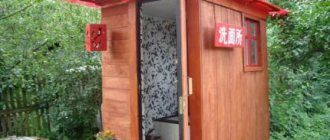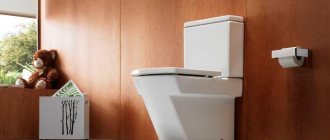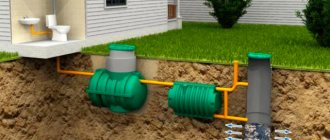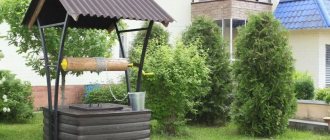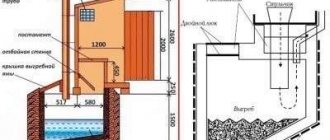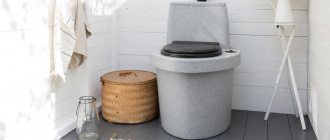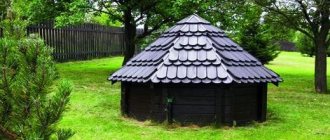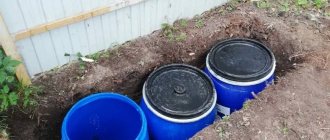30857 0 4
mark_kr August 2, 2016Specialization: professional in the field of construction and repair (full cycle of finishing work, both internal and external, from sewerage to electrical and finishing work), installation of window structures. Hobbies: see the column “SPECIALIZATION AND SKILLS”
There are several ways to ensure comfort when visiting “places of solitude”
A warm toilet and sewerage system in a village house is the dream of every summer resident. And this is quite understandable: if a person has ever run out in the rain into a wooden structure standing near a fence, then he will definitely appreciate the benefits of a bathroom located in the house itself.
In principle, arranging a toilet is not one of the most difficult tasks. Having studied specialized literature and developed a suitable project, it is quite possible to implement it yourself. Of course, you will have to work hard, but you can definitely do it in one season.
What do designers offer?
There are no restrictions on arranging a bathroom in a wooden house. But ethno-styles look more organic:
- Provence He is characterized by the use of pastel colors and ceramic elements. Floral patterns on tiles would be appropriate;
- rustic. The difference is the imitation of the raw surface of natural materials in combination with floral prints;
- rustic. Involves the use of wood in all variations. For rooms with high humidity, either specially treated wooden lining or materials that only imitate natural wood are used.
But modern styles will also be appropriate if they do not stand out from the general concept of the whole house.
Thanks to the exquisite simplicity and texture of the material, harmony in proportions, environmental friendliness and aesthetics, it is these factors that wooden houses have gained high popularity in private housing construction. This trend, which is relevant today, will only develop after a certain period, since a house made from natural raw materials has high performance properties and is relatively inexpensive when compared with brick buildings. Many, realizing the advantages of a log house, are prejudiced by the fact that such a building can be equipped with all the engineering and communication networks present in brick or block houses and apartments.
The concept of incompatibility of a log house with the plumbing installation in it and all the amenities is often associated with a misunderstanding that such a structure is a full-fledged residential structure. You can live in such a building with all the technical amenities, as in an apartment, but you should worry about this yourself, as well as about their functioning and cleaning, without shifting these problems to utility organizations. Note that this is even for the better, because it will be more reliable.
In our article we will talk about the construction and arrangement of a plumbing room in a wooden house, we will discuss the specifics of the organization and important nuances that we may encounter during the work.
Waterproofing
Maximum attention is paid to waterproofing a wooden house. This is more than important; water seeping through the cracks in the finishing will cause the wall to lose strength, resulting in destruction of the wood and expensive repairs.
Rolled waterproofing will help you quickly and efficiently create protection from moisture. This can be classic roofing felt or modern fiberglass-based products. Roofing felt can only be used as a last resort; it is essentially paper, which is not conducive to the durability of the coating.
The first step is to protect the floor. The sheets are laid on a backing made of waterproof wood board or on a concrete base. Each subsequent sheet should be overlapped and the surface should be heated.
When installing bathrooms in houses made of timber, it is enough to soak the walls with an antiseptic. If subsequent cladding is planned, they are also covered with rolled material. The principle applies here: there is no such thing as excessive waterproofing.
Do-it-yourself construction of a country toilet with a backlash-closet with a cesspool with photo
The design and arrangement of a country toilet with a cesspool can be chosen based on the availability of certain building materials on the farm. If the farm does not have boards for constructing a cabin, then you can first build a wooden frame, wrapping it with opaque film or finishing it with roofing felt.
As you can see in the photo, a distinctive feature of a backlash closet is the presence of exhaust ventilation for the cesspool:
A ventilation riser made of asbestos-cement pipe with a diameter of 100-150 mm should be mounted to the rear wall of the booth. To do this, you can build a box made of boards. The width of each side of such a box should be approximately 150 mm. When performing exhaust ventilation of the cesspool, it is necessary to ensure the tightness of all connections, which is the main condition for quality work.
The cesspool for the backlash closet is a pit up to 1.5 m deep, the bottom of which, for ease of cleaning, should be made with a slight slope towards the hatch. A pit toilet can be sealed or filtered. Its design depends on specific conditions. For a large family, it is recommended to build a cesspool with a volume of at least 2 m, and it must be airtight. This type of cesspool is considered the most environmentally friendly, as it does not pollute the soil, but it requires regular cleaning. A filtered cesspool can be cleaned much less frequently, but waste from it will in any case seep into the ground. Such a cesspool is allowed to be installed only if the daily volume of waste is up to 1 m. In addition, when constructing it, it is recommended to use concrete rings for the well.
The top of the cesspool should be insulated so that it does not freeze. You must first lay wooden or reinforced concrete beams above it, and then install and secure the toilet stall on them.
If there is no concrete floor above the pit, the open space should be tightly covered with boards, and roofing material should be placed on top of them.
The bottom of the cesspool should be located 1 m above the maximum (autumn-spring) groundwater level.
Building a toilet with a retractable bucket is a more economical option, but it must be taken into account that feces removed from such a toilet cannot be used as fertilizer; they need to be pre-composted. Under no circumstances should you construct an overflow pit for a toilet that resembles a septic tank and consists of concrete rings or other material, but without a bottom. This design can lead to contamination of groundwater by runoff.
Choosing a wastewater treatment system
The most common method for summer residents is biological treatment.
This method is based on the life process of special bacteria placed in a well or septic tank. Usually used:
- anaerobic,
- aerobic cleaning system.
- The bottom of the wells must be sealed with roofing material or waterproofing (several layers), or cement.
- The joints of reinforced concrete rings must be made airtight. To do this, use cement mortar or liquid glass.
- The well is equipped with a tightly fitted lid with an inspection hatch.
- The contents are discharged at the level of the lower ring or using a sewer truck.
They involve the use of a septic tank - a special container in which the above-mentioned microorganisms decompose the waste of our life. After this, the wastewater enters the soil through the drainage (if the soil does not absorb moisture well enough, then the wastewater goes to the place of filtration, i.e., to the nearest ditch).
It must be taken into account that the septic tank must be at least 5 meters away from the house, and 20 meters from the well. The volume of the septic tank should be three to four times the daily water consumption.
A biological treatment system can be organized in a simpler way - by installing a well made of reinforced concrete rings or one large container:
Types of toilet designs
Before you start building a warm toilet in your country house, you need to decide on its type. Please take into account the requirements described above. The types of this sanitary and hygienic product may be as follows.
Equipped with a cesspool. The most common and simple structure. The cesspool is no more than one and a half meters deep. A toilet house is erected on top of it. During use, waste accumulates and gradually decomposes.
If the hole is not deep enough and does not cope with the task, then there are two options for solving the problem. The first of them involves demolishing the structure and burying a hole. The second involves cleaning the pit with the help of vacuum cleaners or on your own.
Powder closet. Application is convenient in areas with nearby water sources. In this case, there is no need for a cesspool, and it is replaced by a specially equipped container, which is placed directly under the toilet seat. The use of various powders allows you to remove unpleasant odors. Use dry peat, sawdust or ash. This event is similar to powdering, which gives the design its name.
Powder closet
When the container is filled with sewage, its contents are removed to a suitable place. Over time, compost turns into a wonderful fertilizer.
Backlash closet. The design of such a structure requires the presence of a sealed cesspool. Removal of accumulated sewage occurs using special equipment. Most often, such a bathroom is located in a house near the outer wall, and the cesspool is located on the outside of the same wall. The flow of wastewater into it is carried out through a pipe. The pit is constructed with a slope away from the house, which simplifies its cleaning.
Dry toilet. In essence, such a bathroom is a modern modernized powder closet. The difference between these structures is the replacement of peat or sawdust with microorganisms. When installing a dry closet, there is no need to build any structure, since it is a ready-to-use device. There is a wide selection of dry closets in sizes and shapes, which makes it possible to operate the device in the home. For the functioning of this toilet, it becomes necessary to acquire microorganisms. The advantage is the receipt of valuable fertilizer as a result of the decomposition of sewage by biological means.
Dry toilet
Chemical toilet. Its difference from a dry toilet lies in the means that processes wastewater. The use of chemical reagents makes the contents of the toilet unsuitable for further use.
Peat toilet. According to the principle of operation, it is similar to the powder closet, but somewhat modernized. This bathroom resembles a traditional toilet, the cistern of which is filled with dry peat. When using the device, dust is powdered. Often such a structure is installed in a house, having previously organized high-quality ventilation.
Organization of water supply
In order to fully operate a warm country toilet, it is necessary to ensure a constant supply of water to it. There are two options here:
Choosing a location for a country toilet
When organizing an outdoor toilet in your country house, you should adhere to the rules governing construction. More stringent requirements apply to structures with a cesspool. According to sanitary standards, the space allocated for the toilet must meet the conditions described below.
Its location is removed at a distance of more than 25 m from any source of water.
It is important to choose the right place for the toilet
If there is a slope of the terrain on the site, the installation site of the toilet should be lower than the source of water intake. This prevents the penetration of wastewater into the source.
The close location of the building to a neighbor's garden can cause discomfort, so it must be installed at a distance of at least one meter from the border of the plots, and the door should not open in the direction of the neighbors.
The toilet is located in a remote location from all objects located on the site. This applies not only to residential buildings, but also to barns, summer showers, cellars, as well as trees and buildings where pets are kept.
The choice of the type of toilet design is decisively influenced by the depth at which the groundwater lies. There are no restrictions if they are located on a horizon whose depth exceeds 2.5 m. Otherwise, installing a toilet equipped with a cesspool is not allowed.
If it is planned to install a structure that provides isolation of the soil from runoff, then some of the restrictions are removed.
Preparing the toilet.
The largest water plug in terms of volume is in the toilet, and this is understandable - the largest traffic is through the toilet. In addition to the fact that this plug is the largest, it is located in the elbow of the ceramic toilet bowl, which has very low deformation properties. Simply put, when the water in the toilet bowl freezes, the bottom of the knee simply breaks off. Sometimes this happens very nicely and neatly, so that the broken part can be glued back in place, but it’s better not to take risks.
When preserving a dacha for the winter:
- flush the water from the toilet tank several times,
- Shut off the water supply to the toilet tank and flush the water from the tank.
- unscrew the lid of the tank and make sure that there is almost no water left in the tank; if you wish, you can remove the remaining water with a rag or sponge (this is not necessary if there is not much water left in the tank).
- Scoop out as much water as possible from the toilet bowl. It is best to use a special scoop for this, made with a wallpaper knife from a plastic bottle, shaped like a ladle. However, you can scoop out water using any available means.
- Remove any remaining water from the bowl with an old rag or sponge.
- To prevent odors from the sewer network from entering the house in winter, tightly plug the hole in the bowl with a rag.
- You can also throw some rags on top and even close the lid, although this is not necessary:
Working inside a toilet and releasing sewer pipes
To make a toilet in a private house
with a concrete floor, it will be necessary to open part of the screed. To do this, you can use a hammer drill or a hammer. Depending on the height of the floor relative to the ground level, you need to go 30-40 centimeters deeper. First, we determine the exact future location of the toilet - it is chosen arbitrarily, based on the parameters of the room and sound logic. Then we open a trench the width of the pipe from the place where the pipe will come out of the floor to the place where it will go in the direction of the drainage pit or septic tank. Using a hammer drill, we make a hole in the wall at this level slightly larger than the width of the pipe.
Choosing a location for a country toilet
But for many other applications and locations, you now have the latest compact composting toilet as a modern hygienic solution without the added chemicals or other additives like regular camping toilets with this dry cabinet.
The particularly robust design allows for safe biolocus sessions. While the droppings go directly into a collection container lined with a foil bag, the urine is discharged through a hose into an outer container. Its liquid contents can either be disposed of normally as usual or distributed as fertilizer in a tenfold dilution. Dryers are not really necessary due to the separation in the litter box.
After installing the drain pipe (diameter 100-120) and installing the corner joint, releasing it in the toilet upwards just above floor level, fill the remaining space with concrete and let it set. Do not forget about the slope, so it is better to do the filling after the installation and connection of the entire sewer pipe with the septic tank is completed. The trench in which the pipe was laid is filled with earth. If you use steel pipes, then you do not need to further strengthen them. But the plastic pipe is afraid of soil subsidence, so it is necessary to strengthen it. It is fashionable to use a steel case, but this is not economical.
Roof and floor
Subsequent garden composting of course also includes other organic material. This reliably prevents the formation of odors. The opening in the collection container is hidden by a tight-fitting lid that opens when the toilet seat is loaded. The silent fan operates continuously and creates an air flow that passes through the exhaust duct into the open air. The vent pipe is directed outward or connected to an existing vent. The existing lattice cap prevents birds and insects from entering the tube.
Another way out is to pre-fill the screed at the bottom of the trench, strengthening it with steel reinforcement. You can also pour small sides under the formwork, slightly higher in height than the thickness of the pipe. The result is a concrete case, which is covered on top with a tarred board or strips of steel 3-4 mm thick. Everything is covered with earth on top and lightly compacted. This way the pipe will be under reliable protection.
Instead of pipes, flexible hoses can naturally also be used in confined spaces. A convenient alternative for every bathroom with a new design and new design. The powerful fan for 230 V mains connection is adjusted in two stages, the 12 V version has only one stage, the non-electric model depends on nature. The hygienic valve and the rotating mechanism for optimal use of the volume of the collection container automatically provide their services when used. The villa combines very compact dimensions with convenience and long periods of downtime.
Important nuance: ventilation in the bathroom
Availability is no less important than water supply and sewerage. This is explained by the fact that prolonged exposure to a humid environment and the inability to dry the room leads to the formation of mold and the appearance of fungi on natural raw materials, which precedes the destruction of the building material or significant deformations.
Forced ventilation in the restroom should be arranged taking into account compensation gaps between the wooden structure and the air ducts. Fans should be used exclusively for specialized purposes: for rooms with high humidity and with a high class of protection against unauthorized fire. Experts consider the attic to be the most successful location for a ventilation unit.
The ventilation network requires compliance with certain safety requirements: avoid contact of the installation with natural structural elements; The ventilation unit must be mounted only on specially designed bracket stands. Ventilation ducts and the fans themselves must be made of elastic, non-flammable raw materials, and the line must be equipped with fire dampers that block the air flow in a fire situation.
Which toilet is better to make in the country?
The arrangement of any summer cottage should begin with the construction of a toilet, making it the first and most important building on the garden plot. If the site is needed only for spending weekends in nature in the summer, then you can build a relatively light structure from scrap materials using simple tools. If the dacha involves permanent residence or long-term stay, then it is necessary to provide for the construction of a more permanent toilet structure.
What types of country toilets are there and what are their advantages? Most often, in summer cottages there is no sewerage system, so in such cases, yard toilets are mainly built. Using such a toilet can cause some inconvenience, especially in inclement weather. There are also certain advantages of a yard toilet: due to its location away from the country house, there are no unpleasant odors in living quarters.
If you have not yet decided which toilet is best to make in your dacha, you will have to choose from three design options: powder closets, toilets with a cesspool or with a retractable bucket.
Look at photos of different types of country toilets before you start choosing a design:
A country toilet stall is most often made of wood, giving it various shapes, even cone-shaped. It is this form that is convenient for placing drawers for storing peat, sawdust, ash, etc. in the extended base of the toilet.
It is recommended to make a country toilet cubicle from boards or light boards tightly fitted to each other. This type of construction is the simplest and does not require a lot of money and time.
Which toilet to choose for your dacha is up to the owner of the site to decide. Remember that a yard is a waste collection area, so the design of the method of collection of this waste makes the determining difference in the options for these buildings.
Which toilet for a summer house is better, and what their differences are, you will find out on this page.
Examples of finished projects
One of the simplest solutions for country toilets, which are used everywhere, is the construction of a “birdhouse”. This is the name given to a standard rectangular restroom. Most often it has a pitched roof, which is made of slate. Below you can see a drawing indicating the dimensions of just such a restroom. Among the disadvantages, it is worth noting that the restroom is unstable to loads, as well as the need for additional upholstery material that will eliminate drafts.
If you want something more intricate, then you can build a triangular toilet. It is called a hut. This is exactly what it resembles with its shape. The triangle is one of the most stable shapes, so such a toilet can withstand both wind and snow loads. Unlike the previous option, snow cover will not be able to accumulate on such a latrine. Below is a drawing showing all the dimensions of the restroom. You should not save when choosing the width of the toilet. If you make it too small, then it will be almost impossible to stand up to your full height in the restroom.
A more complex toilet option for making in the country is a diamond-shaped toilet. It is also called a hut. Such a restroom will require significant consumption of building material. But with such a toilet you can be sure of stability even in strong winds. Another solution would be to build a restroom in the shape of a small house. It usually has a gable roof and is constructed from any type of materials.
Construction from scratch - restroom design
In this case, everything is simple, since toilets are provided for in the project and can be placed on each floor of the future house. It is advisable to provide their location in such a way that they have a single sewer riser, which will save time and material resources spent on construction. Everything will depend on the specific project and the layout of the house. It is advisable that toilets and bathrooms do not have common walls with living rooms. Ideally, these could be external walls, partitions with corridors or technical rooms. Also, toilets and bathrooms should not be located above living rooms.
Raw humus is removed only after a few months through the back flap. The seat ring is also made of this material and is therefore pleasantly warm. Thus, it is mainly suitable for unheated external toilets. The 200 l container allows one year of operation without emptying.
If kitchen waste is added occasionally, In the process of emptying almost the right compost "harvest" - depending on the length of stay. The leaking liquid is passed into an external canister. Occasional addition of bark increases composting efficiency.
Ventilation of a wooden house bathroom
Due to constant humidity in the bathroom or toilet, high-quality ventilation is simply necessary here. You can make a natural hood. That is, ventilation openings with grilles are made in the upper and lower parts of the room, and warm air rises through them and carries away excess moisture.
But such a hood is not always enough, so a fan is needed that will draw out excess moisture and unpleasant odors. The power of such a device depends on the area of the room. Before purchasing a fan, it is better to consult with a specialized specialist who will calculate the optimal fan power for your bathroom.
House
The house is a curious form of country toilet, allowing for a wide variety of design delights. In comparison with all the other forms listed above, the house seems to be the warmest and most comfortable option. In addition, it is characterized by increased strength, and the costs of land and materials are the same as when building a less warm and comfortable birdhouse.
6 drawings of a country toilet of the “House” type
There are also such drawings. Using this scheme, we managed to assemble a toilet for only 7,500 rubles. How? See the construction progress and results here
Also, a country toilet, depending on the area it occupies and the features of the construction, can be either single or double.
Example of a double toilet
Attached to a garage or any other building are more complex toilet structures that are not so often in demand by summer residents.
High-quality thermal insulation using polyurethane foam
Now, this material has become very widespread due to its versatility and excellent characteristics that distinguish it from other thermal insulation materials. In general, polyurethane foam can be used as insulation for both exterior and interior decoration.
The main advantages of polyurethane foam as insulation for outdoor toilets:
In addition, insulation of a toilet located on the street with polyurethane foam is universal. This is due to the possibility of using polyurethane foam boards. They are frozen forms of polyurethane foam that are used for thermal insulation of a room. Thus, PPU slabs are successfully used, which increases their heat capacity in general.
The main advantages of polyurethane foam boards can be considered the following:
- High density of contact with walls. Regardless of what material the outdoor toilet is made of, the slabs do not form cracks and gaps through which heat loss occurs.
- High resistance to physical stress and deformation. Due to their structure, polyurethane foam boards do not lose their shape throughout their entire service life.
- If installed correctly, the material will not lose its thermal insulation characteristics for 70 years.
- Complete environmental safety.
- If moisture gets in, the insulation will absorb no more than 2% of its mass. The rest of the liquid will not touch the walls of the toilet.
Method 2. Install a heater
You can purchase an infrared outdoor heater with protection class IPX5. Such a device is protected from splashing water and is more economical than a gas heater. However, purchasing an IR device will cost 3-4 thousand rubles.
Another option to warm up the toilet is a fan. Take devices with ceramic heating elements, they quickly increase the temperature and cost around 1000 rubles. Such devices will instantly warm up the cabin - you turn on the fan at home and by the time you reach the toilet, it will become warm inside.
To insulate a cabin with a heater, you either need to know how to install the electrics yourself, or hire a specialist.
Varieties
Traditional options
Different types of toilets for dachas require different approaches to arrangement, therefore, before starting work on installing a sewer system, it is worth studying all the available options and analyzing their pros and cons.
So, what can you choose for a suburban area:
The simplest design is a wooden or plastic-lined booth installed directly above. This option is the least expensive in terms of equipment, but the comfort it provides is very conditional: it’s cold, the wind blows through the cracks, and there’s a bad smell inside.
The advantages of dry toilets include ease of use and the ability to move from place to place. The disadvantages are the need to regularly replace filling containers (the cost of the service company’s work can be very high). And in winter it’s still quite uncomfortable in such a booth.
Innovative solutions
If you want to equip a winter toilet (i.e.
one that can be used throughout the year without the risk of catching a cold), then in addition to traditional solutions, you can also pay attention to modern models
Some of them are presented in the following table:
| Device type | Operating principle |
| Compost with partial recycling of waste | Peat or a mixture of peat and sawdust is used as a reagent. When interacting with wastewater, the material is effectively composted. In modern models, peat is filled using an automatic dispenser. |
| Compost with full recycling of waste | It differs from the version with partial recycling in the large volume of the waste bin. Long-term storage of wastewater allows for more efficient composting of feces, turning it into a fairly productive organic fertilizer. |
| Separation | During the operation, the liquid and solid fractions are separated. This allows faeces to be recovered for composting and better treatment of wastewater with high moisture content through filtration. |
| Thermal | Waste disposal is carried out by burning it to ash. Combustion is carried out in a special thermally insulating container using an incandescent spiral or an open flame. The main disadvantage of this technology is the high power consumption (up to 5 kW). |
| Freezing | Perhaps the most unusual toilet described in this section. It consists of a container and a container for freezing waste. Deep freezing allows you to avoid the appearance of an unpleasant odor, in addition, almost all microorganisms are destroyed during the cryotreatment process. As a result, fecal matter becomes completely suitable for composting. The main disadvantage is energy dependence. |
As you can see, such devices can significantly optimize the process of removing sewage. At the same time, for their operation it is necessary to have a source of electricity, therefore, when installing them, renting a diesel generator for a summer residence will move from the “desirable” category to the “necessary” category.
Popular materials
Sewage type
- toilet without sewerage. There are several types that can be arranged in different ways. All of them are united by one feature - there is no pipeline system through which wastewater and organic waste move;
- autonomous sewer system. Various options can also be used here - from a regular cesspool to a septic tank or biological wastewater treatment station.
Where to place it?
A village house built during the Soviet era most likely has a number of utility rooms - storage rooms, closets, etc. It will be good if the area is located in close proximity to a cesspool or septic tank - this will eliminate the need to lay extra pipes and reduce costs. If the room is of sufficient size, you can design a combined bathroom by placing a bathtub and a latrine in it. There will also be washing machines and dryers there.
Recommendation: immediately lay sound insulation between the walls so as not to create inconvenience for the people living in the house.
If there is no suitable place, and you are determined to find out how to build a warm toilet , the right choice would be to build partitions from chipboard, plasterboard, etc. materials right in the kitchen, building an entrance in the adjacent wall.
What to do if there is no sewerage?
It is not always possible and necessary to create a complex waste disposal system. Is it necessary? There is a certain level of comfort, but there are also enough expenses. You can equip your bathroom in a different way by installing a toilet without a sewer - this is a chemical or peat toilet , which is a truly environmentally friendly solution.
READ How to make extensions to the front door
Such designs will not only allow you to enjoy modern conveniences, but will also add a couple of kilograms of fertilizer to your garden. The village exists to enjoy nature, while cesspools and septic tanks, no matter how perfect they are, spoil the environment.
Selecting a location
The easiest way is if you are building a house from scratch. Then the location of the toilet is determined by the project, and no additional research is required from the owner. However, most often the situation is this - there is a country or country house with a standard booth over a cesspool in the garden. And I want to make a warm, modern bathroom. Then you have to decide how to make a toilet in the house if there is no sewage system.
In addition to organizing an autonomous system, you need to decide which room to allocate for a toilet in a private house with a sewer system. The following options are usually used:
- a small separate room already available in the house;
- construction of a wall separating a room of the appropriate size from the room;
- construction of an insulated extension with an entrance device through an external wall.
The main criterion is not so much the choice of a specific room, but the determination of the sewerage layout and the installation point of the riser. It is necessary to consider all possible options, the simplest of which would be a warm toilet in a wooden house without a sewer system. As a rule, this is a specially equipped room with a dry closet. However, there are more complex designs that need to be considered more carefully.
